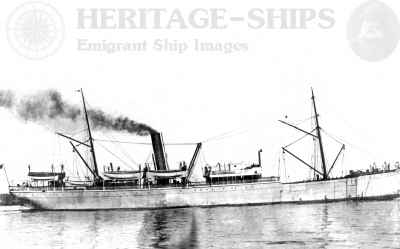The Romeo was built in 1881 by Earle's Shipbuilding & Eng. Co, Ltd. of
Hull for the Wilson Line of Hull. Tonnage was 1 840 tons gross, 1 376 under deck and 1 210 net. Poop was 370 tons and forecastle 41 tons. Rigging: iron construction, single screw, 2 masts steam Schooner, 2 decks, one of iron, 3 bulkheads and 2 partial bulkheads, one funnel. Propulsion:
compound engine with 2 inverted cylinders of 38 & 76 in. boiler 80lb per sq.in. diameter respectively, stroke 48 inches, 350 nominal horsepower giving a speed of 12,5 knots. The engine was built by the same company as the hull.
She had first class accommodation for 38 passengers in staterooms on either side of the ship abaft a large well-fitted saloon, see the image below. Aft in the poop there was accommodation for 18 second class passengers. She could accommodate 780
steerage passengers in three different compartments, two aft, the other forward. The after compartment (compartment 1), formed a portion of a long poop, and was between the second class accommodation and the engine-room. It was fitted with open berths in two tiers, the berthing space of each individual separated by a moveable board eight inches high. Compartment 2 was under compaertment 1, but was not so long, and was fitted with berths on the shelf principle, with two shelves on each side of the vessel running the entire length of the compartment. The shelves had no sub-divisions of any kind denoting the berthing space of each emigrant. Compartment 3 was a large "
tween deck", forward, fitted in the same way as compartment 1. Each of the Compartments had wooden decks, and were well lighted and ventilated. They were entered by ladders coming down the hatchways abreast of each other at an easy angle, lined at the backs, and fitted with hand-rails, and the entrances protected by substantial booby hatches. Compartment 2 was set aside for the accommodation of single women. The water-closet arrangements of the vessel for Compartments 1 and 2 were at the after end of Compartment 1, males and females on opposite sides of the deck. There was a constant supply of water flowing through them, they were fairly ventilated and lighted, and fully protected from the weather. Forward the water-closets were under the topgallant forecastle, and were the same as those aft, but not so well protected from the weather. The decks were sprinkled with disinfectants and covered with sawdust, and were swept up after meals.
The Romeo was mainly trafficking the route between Gothenburg and Hull, a voyage that normally would take 42 hours.
|
|
 Romeo - Wilson Line steamship, white hull Support Norway Heritage: Purchase a copy |
The Wilson line did not only offer conveyance of emigrants from Scandinavian countries to England. During the passenger season they also offered accommodation for the comfort of tourists, and arranged holiday tours to different parts of Norway and Sweden. The accommodation was strictly first class in saloons and stateroom amidships, much different from that was offered to the comfort of the emigrants traveling steerage between decks.